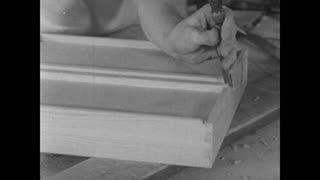“Americans at Work” is a short-lived televised series created to showcase modern improvements in industry at the close of the 1950’s. It is an ode to the American industry worker. Episodes ran for about fifteen minutes long and covered wide swaths of topics including steel mill and textile workers. The AFL-CIO; founded through a merger of two trade unions in 1955 still operates today with much less power unfortunately as union membership saw a drastic decline following the 1950’s. This particular episode takes a look at the intricate process of hand making furniture at a time when the craft was becoming more mechanized. It traces the heritage behind American furniture production beginning in colonial times and moving towards the modern era. It shows various traditional methods including dovetailing drawers and intricate detail work on bedposts and other furniture pieces. These methods are enhanced through modern innovations such as synthetic glues and precise machinery. Viewers learn terminology of the trade well as the history behind various woods used for various pieces. “Americans at Work” dates to 1959-1960. In 1958, AFL-CIO Secretary-Treasurer, William F. Schnitzler, announced the production of 52 films to run weekly for one year. The popularity of the series persuaded the AFL-CIO to extend the project by an additional 52 films. The AFL-CIO Public Relations Department, led by director Albert J. Zack and assistant director Robert J. Wentworth, primarily coordinated the production and distribution of the series. Production was contracted to Norwood Studios, Inc. of Washington, DC, which was founded and managed by Phillip M. Martin.
00:00 The film opens with a furniture maker and homeowner looking over handcrafted pieces in her home (:09) including serpentine sideboards (:38) and the delicate trimmings of a breakfront (:48). Union craftsmen work to recreate classics from the colonial era (:56). The title screen appears (1:06). The film was presented by the AFL-CIO (1:13). The modern furniture maker is accompanied by power tools (1:26) such as the swing cut off saw (1:28). A band saw operator makes cuts on mahogany wood (1:55) to form a cabriole leg. Rough planks are pushed through a plating machine (2:28). Ribbing machines (2:54) are put to use. Rollers return the cut pieces to the operator (2:59). Wood pieces will be used to form table tops (3:03). Machinery rough carves table legs (3:31). Narration compares colonial methods (3:34). Finished legs are pictured (3:50). Tools used by the spindle carver (4:02) include diamond points and square noses. Simple formed pieces such as the table top (4:27) are compared to the more intricately formed capriole leg (4:44). A particular piece features Chinese design representing a dragon claw (4:55). Close shots return to the works of a hand carver at (5:24) and at (5:50). Two workers hand sand chairs and a table frame (6:28). Drawers are expertly dovetailed (7:01). Tent beds are formed; replicated from the Revolutionary war period (7:31). Another tradition of artisans is to burn a trademark into wood (7:46). Modern innovations include imbedding a dowel in synthetic glue (8:06). A block front chest gets reproduced (8:31). The process for antiquing is sampled on headboard for a bed (8:44). The complex finishing process (9:02) is shown including spray painting (9:30) and highlighting the grain pattern (9:51). A table gets covered with glue (10:15) to receive a decorative covering. Narration explains Chinese influence on the American craft (10:17). The covering is smoothed over (10:41). Machine tacks on gold tooling (11:12) on a leather table top. A section explains the history behind the carved scallop shell (11:15). Delicate furniture pieces get wrapped prior to shipment (11:50). The final segment pays tribute to the works of the handicraftsmen able to deliver works reminiscent of various heritages and time periods (12:34). Presented by the AFL-CIO (13:18).
Motion picture films don’t last forever; many have already been lost or destroyed. For almost two decades, we’ve worked to collect, scan and preserve the world as it was captured on 35mm, 16mm and 8mm movies — including home movies, industrial films, and other non-fiction. If you have endangered films you’d like to have scanned, or wish to donate celluloid to Periscope Film so that we can share them with the world, we’d love to hear from you. Contact us via the weblink below.
This film is part of the Periscope Film LLC archive, one of the largest historic military, transportation, and aviation stock footage collections in the USA. Entirely film backed, this material is available for licensing in 24p HD, 2k and 4k. For more information visit http://www.PeriscopeFilm.com


